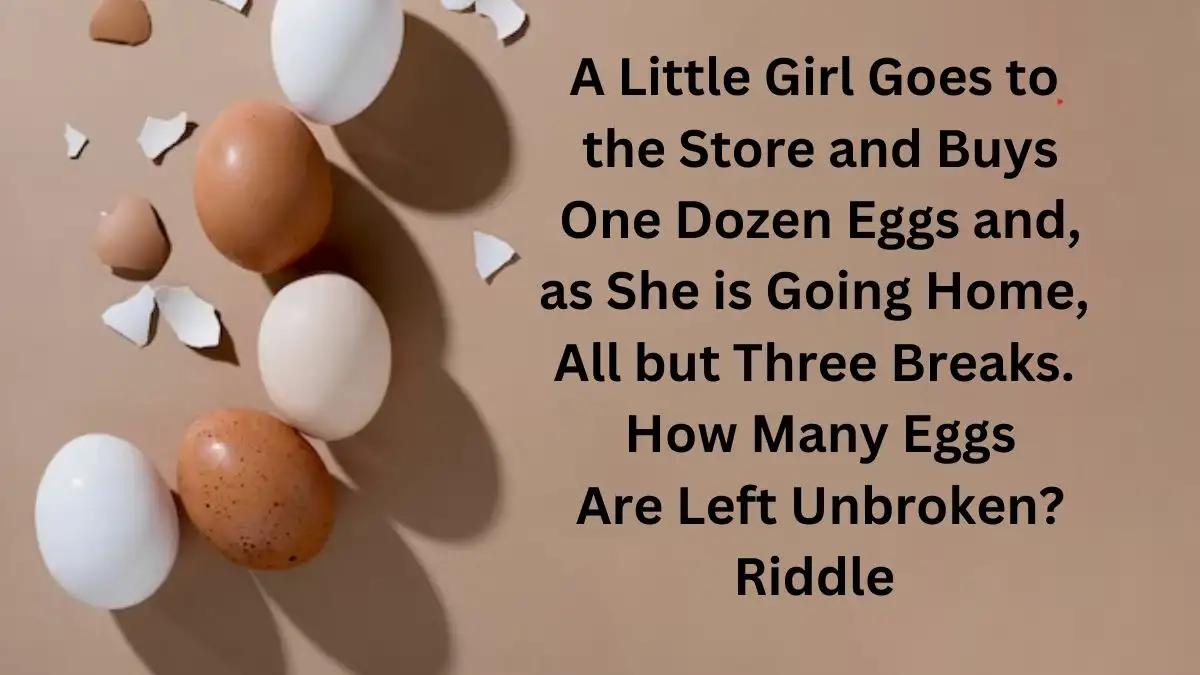A Little Girl Goes to the Store and Buys One Dozen Eggs and, as She is Going Home, All but Three Breaks. How Many Eggs Are Left Unbroken? Riddle Answer
by Priyanka P
Updated Jan 29, 2024

A Little Girl Goes to the Store and Buys One Dozen Eggs and, as She is Going Home, All but Three Breaks. How Many Eggs Are Left Unbroken? Riddle
A little girl went to the store and bought a dozen eggs. On her way home, something unfortunate happened—most of the eggs broke, leaving only a few intact. Specifically, only three eggs remained unbroken. The riddle prompts us to figure out the total number of eggs that are still whole after the mishap.
To solve the riddle, we need to remember that a dozen means 12. So, the little girl initially had 12 eggs. Unfortunately, all but three broke during her journey. The answer to the riddle lies in subtracting the number of broken eggs (which is implied by "all but three") from the total initial count of eggs. This straightforward calculation reveals the number of eggs that managed to stay unbroken. It's a simple arithmetic solution that highlights the importance of paying attention to details in the wording of the riddle.
The riddle collection spans from classic brainteasers to cryptic enigmas, offering a diverse range of challenges that cater to all puzzle enthusiasts. Find all these amazing puzzles at Fresherslive.
A Little Girl Goes to the Store and Buys One Dozen Eggs and, as She is Going Home, All but Three Breaks. How Many Eggs Are Left Unbroken? Riddle Explained
A little girl bought a dozen eggs, which means she got 12 eggs from the store. Unfortunately, on her way home, most of the eggs broke, leaving only three unbroken. To find out how many eggs are left intact, we need to subtract the number of broken eggs from the total. In this case, we subtract three (the ones that are still whole) from twelve (the initial number of eggs).
The calculation is 12 - 3, which equals 9. So, there are 9 unbroken eggs left. The riddle challenges us to use basic arithmetic and carefully read the information provided to arrive at the correct answer. It teaches us to pay attention to details and think logically to solve simple puzzles.
What is Riddle?
A riddle is a type of puzzle or word game that presents a mystery or question in a clever and often cryptic way. It typically involves a statement, question, or phrase with a hidden or double meaning, challenging the person to figure it out.
Riddles come in various forms, such as enigmas, which require creative thinking and metaphorical interpretation, and conundra, which rely on wordplay or puns in the question or answer.
Riddles have been part of human culture for centuries and can be found in many different cultures worldwide. They are like brain teasers, designed to engage the mind and encourage problem-solving. People enjoy riddles for the mental challenge and the satisfaction of unraveling the hidden meaning.
Advantages of Solving Riddle
Solving riddles offers several advantages, making it an enjoyable and beneficial activity:
Mental Stimulation:
Riddles require critical thinking, creativity, and problem-solving skills. When you solve a riddle, you exercise your brain, keeping it active and sharp.
Enhanced Problem-Solving Skills:
Riddles often present complex challenges in a concise format. Solving them hones your ability to analyze information, think logically, and find innovative solutions.
Improved Language Skills:
Riddles play with words, encouraging better vocabulary, wordplay, and linguistic comprehension. They can be an enjoyable way to learn new words and phrases.
Boosted Confidence:
Successfully solving a challenging riddle can be incredibly satisfying, leading to increased self-confidence and a sense of accomplishment.
Entertainment:
Riddles are a source of entertainment and amusement, whether solved individually or as part of a group. They can be a fun way to pass the time.
Social Interaction:
Riddles often prompt discussions and interactions among people trying to solve them together, fostering teamwork and communication.
Cultural Understanding:
Riddles are found in many cultures, and solving riddles from different parts of the world can offer insights into diverse perspectives and traditions.
A Little Girl Goes to the Store and Buys One Dozen Eggs and, as She is Going Home, All but Three Breaks. How Many Eggs Are Left Unbroken? Riddle - FAQs
A riddle is a type of puzzle or word game that presents a mystery or question in a clever way, challenging individuals to decipher its hidden meaning.
To solve a riddle, carefully analyze the information provided, consider wordplay or double meanings, and use critical thinking to arrive at the correct answer.
Solving riddles stimulates mental activity, enhances problem-solving skills, improves language abilities, boosts confidence, provides entertainment, encourages social interaction, and contributes to cultural understanding.
Riddles have been part of human culture for centuries and can be found in various forms across different cultures worldwide.
People enjoy solving riddles for the mental challenge, satisfaction of unraveling hidden meanings, and the enjoyment derived from engaging in a playful and intellectually stimulating activity.







